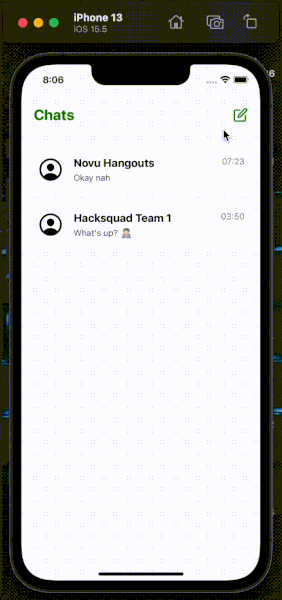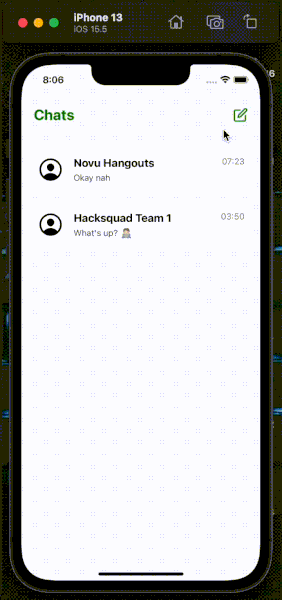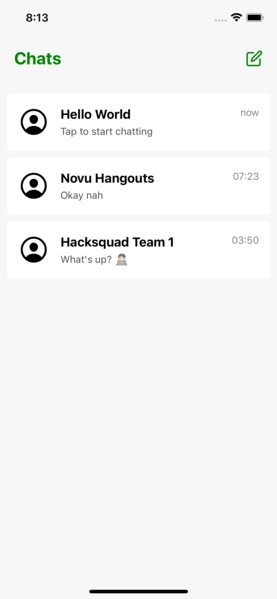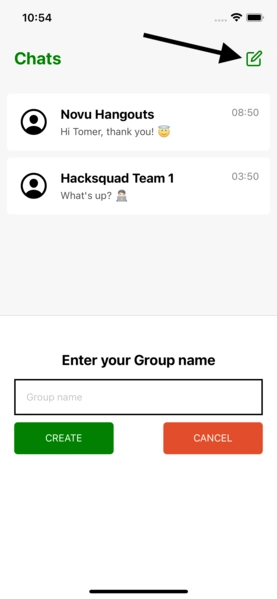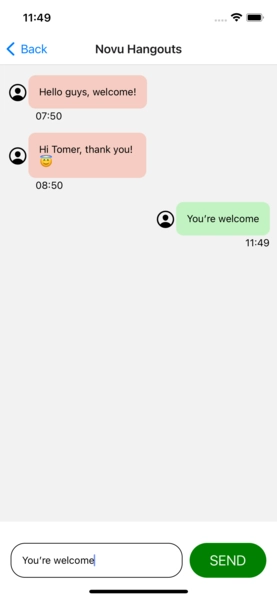使用 Socket.io 和 React Native 构建聊天应用程序🤯
查看Postiz - 开源社交媒体调度工具。
我之前写过关于如何使用 React 构建聊天应用程序的文章,它获得了 1660 个赞和 52955 次浏览量🤩
所以我决定为 React Native 制作另一个。
这篇文章是关于什么的?
聊天无处不在,从 Whatsapp 到 Facebook 和 Instagram,几乎每个平台都提供某种形式的聊天。
在当今的数字世界里,我们都已经离不开移动设备了!就在写这篇文章之前,我在Whatsapp上给一位朋友发了一条消息。
聊天很有趣,你给一个人或一个群组发消息,他们看到后会回复。简单却又复杂。
要开发一个聊天应用,你需要在收到新消息时立即收到通知。
在本文中,我们将做一些与之前的 React 教程略有不同的事情。我们将创建一个登录屏幕,您可以在其中输入您的姓名,创建可供人们加入的群组,并在群组成员之间显示实时消息。
从服务器获取实时信息ℹ️
有两种方法可以从服务器获取有关新出价的实时信息:
使用长轮询 HTTP 请求,基本上每 5 - 10 秒发送一次 HTTP 请求来获取有关新出价的信息。
当新的出价到达时,使用开放套接字(Websockets)直接从服务器获取信息。
在本文中,我将讨论Websockets,特别是 Node.js 库 - Socket.io
Socket.io是一个流行的 JavaScript 库,它允许我们在软件应用程序和 Node.js 服务器之间创建实时、双向通信。
Novu——第一个开源通知基础设施
简单介绍一下我们。Novu 是第一个开源通知基础设施。我们主要负责管理所有产品通知。通知可以是应用内通知(类似于开发者社区的Websockets中的铃铛图标)、电子邮件、短信等等。
如果你能给我们一颗星,我会非常高兴!这会帮助我每周写更多文章🚀
https://github.com/novuhq/novu

我们在 Hacktoberfest 期间送出一些超棒的礼物 😇
如何在 React Native 和 Socket.io 之间创建实时连接
在本教程中,我们将使用Expo构建聊天应用程序 - Expo 是一个开源框架,使我们能够通过编写 React 和 JavaScript 代码为 IOS 和 Android 创建原生应用程序。
安装 Expo
Expo使我们免于使用React Native CLI 创建本机应用程序所需的复杂配置 ,使其成为构建和发布 React Native 应用程序最简单、最快捷的方式。
确保你 的计算机上安装了Expo CLI、 Node.js和 Git 。然后,通过运行以下代码创建项目文件夹和 Expo React Native 应用。
mkdir chat-app
cd chat-app
expo init app
Expo 允许我们使用托管工作流或裸工作流创建原生应用程序。在本教程中,我们将使用空白的托管工作流,因为所有必要的配置都已完成。
? Choose a template: › - Use arrow-keys. Return to submit.
----- Managed workflow -----
❯ blank a minimal app as clean as an empty canvas
blank (TypeScript) same as blank but with TypeScript configuration
tabs (TypeScript) several example screens and tabs using react-navigation and TypeScript
----- Bare workflow -----
minimal bare and minimal, just the essentials to get you started
将 Socket.io 客户端 API 安装到 React Native 应用程序。
cd app
expo install socket.io-client
socket.js在文件夹中创建一个utils并将以下代码复制到文件中
mkdir utils
touch socket.js
//👇🏻 Paste within socket.js file
并添加
import { io } from "socket.io-client";
const socket = io.connect("http://localhost:4000");
export default socket;
上面的代码片段创建了与该 URL 托管的服务器的实时连接。(我们将在接下来的部分中创建服务器)。
在文件夹中创建一个styles.js文件utils,并将以下代码复制到该文件中。它包含聊天应用程序的所有样式。
import { StyleSheet } from "react-native";
export const styles = StyleSheet.create({
loginscreen: {
flex: 1,
backgroundColor: "#EEF1FF",
alignItems: "center",
justifyContent: "center",
padding: 12,
width: "100%",
},
loginheading: {
fontSize: 26,
marginBottom: 10,
},
logininputContainer: {
width: "100%",
alignItems: "center",
justifyContent: "center",
},
logininput: {
borderWidth: 1,
width: "90%",
padding: 8,
borderRadius: 2,
},
loginbutton: {
backgroundColor: "green",
padding: 12,
marginVertical: 10,
width: "60%",
borderRadius: "50%",
elevation: 1,
},
loginbuttonText: {
textAlign: "center",
color: "#fff",
fontWeight: "600",
},
chatscreen: {
backgroundColor: "#F7F7F7",
flex: 1,
padding: 10,
position: "relative",
},
chatheading: {
fontSize: 24,
fontWeight: "bold",
color: "green",
},
chattopContainer: {
backgroundColor: "#F7F7F7",
height: 70,
width: "100%",
padding: 20,
justifyContent: "center",
marginBottom: 15,
elevation: 2,
},
chatheader: {
flexDirection: "row",
alignItems: "center",
justifyContent: "space-between",
},
chatlistContainer: {
paddingHorizontal: 10,
},
chatemptyContainer: {
width: "100%",
height: "80%",
alignItems: "center",
justifyContent: "center",
},
chatemptyText: { fontWeight: "bold", fontSize: 24, paddingBottom: 30 },
messagingscreen: {
flex: 1,
},
messaginginputContainer: {
width: "100%",
minHeight: 100,
backgroundColor: "white",
paddingVertical: 30,
paddingHorizontal: 15,
justifyContent: "center",
flexDirection: "row",
},
messaginginput: {
borderWidth: 1,
padding: 15,
flex: 1,
marginRight: 10,
borderRadius: 20,
},
messagingbuttonContainer: {
width: "30%",
backgroundColor: "green",
borderRadius: 3,
alignItems: "center",
justifyContent: "center",
borderRadius: 50,
},
modalbutton: {
width: "40%",
height: 45,
backgroundColor: "green",
borderRadius: 5,
alignItems: "center",
justifyContent: "center",
color: "#fff",
},
modalbuttonContainer: {
flexDirection: "row",
justifyContent: "space-between",
marginTop: 10,
},
modaltext: {
color: "#fff",
},
modalContainer: {
width: "100%",
borderTopColor: "#ddd",
borderTopWidth: 1,
elevation: 1,
height: 400,
backgroundColor: "#fff",
position: "absolute",
bottom: 0,
zIndex: 10,
paddingVertical: 50,
paddingHorizontal: 20,
},
modalinput: {
borderWidth: 2,
padding: 15,
},
modalsubheading: {
fontSize: 20,
fontWeight: "bold",
marginBottom: 15,
textAlign: "center",
},
mmessageWrapper: {
width: "100%",
alignItems: "flex-start",
marginBottom: 15,
},
mmessage: {
maxWidth: "50%",
backgroundColor: "#f5ccc2",
padding: 15,
borderRadius: 10,
marginBottom: 2,
},
mvatar: {
marginRight: 5,
},
cchat: {
width: "100%",
flexDirection: "row",
alignItems: "center",
borderRadius: 5,
paddingHorizontal: 15,
backgroundColor: "#fff",
height: 80,
marginBottom: 10,
},
cavatar: {
marginRight: 15,
},
cusername: {
fontSize: 18,
marginBottom: 5,
fontWeight: "bold",
},
cmessage: {
fontSize: 14,
opacity: 0.7,
},
crightContainer: {
flexDirection: "row",
justifyContent: "space-between",
flex: 1,
},
ctime: {
opacity: 0.5,
},
});
安装 React Navigation 及其依赖项。React Navigation 允许我们在 React Native 应用程序中从一个屏幕导航到另一个屏幕。
npm install @react-navigation/native
npx expo install react-native-screens react-native-safe-area-context
设置 Socket.io Node.js 服务器
在这里,我将指导您创建 Socket.io Node.js 服务器,以便与 React Native 应用程序进行实时通信。
server在项目文件夹中创建一个文件夹。
cd chat-app
mkdir server
导航到服务器文件夹并创建一个package.json文件。
cd server & npm init -y
安装 Express.js、CORS、Nodemon 和 Socket.io 服务器 API。
npm install express cors nodemon socket.io
Express.js 是一个快速、简约的框架,它提供了多种用于在 Node.js 中构建 Web 应用程序的功能。CORS 是一个 Node.js包 ,允许不同域之间进行通信。
Nodemon 是一个 Node.js 工具,它在检测到文件更改后会自动重启服务器,而 Socket.io 允许我们在服务器上配置实时连接。
创建一个index.js文件 - Node.js 服务器的入口点。
touch index.js
使用 Express.js 设置一个简单的 Node.js 服务器。下面的代码片段会在浏览器中访问时返回一个 JSON 对象http://localhost:4000/api。
//👇🏻 index.js
const express = require("express");
const app = express();
const PORT = 4000;
app.use(express.urlencoded({ extended: true }));
app.use(express.json());
app.get("/api", (req, res) => {
res.json({
message: "Hello world",
});
});
app.listen(PORT, () => {
console.log(`Server listening on ${PORT}`);
});
导入 HTTP 和 CORS 库以允许客户端和服务器域之间进行数据传输。
const express = require("express");
const app = express();
const PORT = 4000;
app.use(express.urlencoded({ extended: true }));
app.use(express.json());
//👇🏻 New imports
const http = require("http").Server(app);
const cors = require("cors");
app.use(cors());
app.get("/api", (req, res) => {
res.json({
message: "Hello world",
});
});
http.listen(PORT, () => {
console.log(`Server listening on ${PORT}`);
});
接下来,将 Socket.io 添加到项目中,以创建实时连接。在app.get()代码块之前,复制以下代码:
//👇🏻 New imports
.....
const socketIO = require('socket.io')(http, {
cors: {
origin: "<http://localhost:3000>"
}
});
//👇🏻 Add this before the app.get() block
socketIO.on('connection', (socket) => {
console.log(`⚡: ${socket.id} user just connected!`);
socket.on('disconnect', () => {
socket.disconnect()
console.log('🔥: A user disconnected');
});
});
从上面的代码片段中,该socket.io("connection")函数与 React 应用程序建立连接,然后为每个套接字创建一个唯一的 ID,并在刷新应用程序时将该 ID 记录到控制台。
当您刷新或关闭应用程序时,套接字会触发断开事件,表明用户已与套接字断开连接。
通过将启动命令添加到package.json文件中的脚本列表中来配置 Nodemon。下面的代码片段使用 Nodemon 启动服务器。
//👇🏻 In server/package.json
"scripts": {
"test": "echo \\"Error: no test specified\\" && exit 1",
"start": "nodemon index.js"
},
您现在可以使用以下命令通过 Nodemon 运行服务器。
npm start
构建用户界面
在这里,我们将创建聊天应用程序的用户界面,以便用户登录、创建聊天室和发送消息。该应用程序分为三个屏幕 - 登录屏幕、聊天屏幕和消息屏幕。
首先,让我们设置 React Navigation。
在应用程序文件夹中创建一个screens文件夹,添加登录、聊天和消息组件并"Hello World"在其中呈现文本。
mkdir screens
touch Login.js Chat.js Messaging.js
将以下代码复制到App.js应用程序文件夹内的文件中。
import React from "react";
//👇🏻 app screens
import Login from "./screens/Login";
import Messaging from "./screens/Messaging";
import Chat from "./screens/Chat";
//👇🏻 React Navigation configurations
import { NavigationContainer } from "@react-navigation/native";
import { createNativeStackNavigator } from "@react-navigation/native-stack";
const Stack = createNativeStackNavigator();
export default function App() {
return (
<NavigationContainer>
<Stack.Navigator>
<Stack.Screen
name='Login'
component={Login}
options={{ headerShown: false }}
/>
<Stack.Screen
name='Chat'
component={Chat}
options={{
title: "Chats",
headerShown: false,
}}
/>
<Stack.Screen name='Messaging' component={Messaging} />
</Stack.Navigator>
</NavigationContainer>
);
}
登录屏幕
将下面的代码复制到Login.js文件中。
import React, { useState } from "react";
import {
Text,
SafeAreaView,
View,
TextInput,
Pressable,
Alert,
} from "react-native";
//👇🏻 Import the app styles
import { styles } from "../utils/styles";
const Login = ({ navigation }) => {
const [username, setUsername] = useState("");
//👇🏻 checks if the input field is empty
const handleSignIn = () => {
if (username.trim()) {
//👇🏻 Logs the username to the console
console.log({ username });
} else {
Alert.alert("Username is required.");
}
};
return (
<SafeAreaView style={styles.loginscreen}>
<View style={styles.loginscreen}>
<Text style={styles.loginheading}>Sign in</Text>
<View style={styles.logininputContainer}>
<TextInput
autoCorrect={false}
placeholder='Enter your username'
style={styles.logininput}
onChangeText={(value) => setUsername(value)}
/>
</View>
<Pressable onPress={handleSignIn} style={styles.loginbutton}>
<View>
<Text style={styles.loginbuttonText}>Get Started</Text>
</View>
</Pressable>
</View>
</SafeAreaView>
);
};
export default Login;
代码片段接受用户的用户名并将其记录在控制台上。
让我们更新代码并使用 异步存储保存用户名,这样用户就不需要在每次启动应用程序时登录。
💡 *Async Storage 是一个 React Native 包,用于在原生应用中存储字符串数据。它类似于 Web 上的本地存储,可用于存储 token 和各种字符串格式的数据。*
运行以下代码来安装异步存储
expo install @react-native-async-storage/async-storage
更新handleSignIn通过 AsyncStorage 保存用户名的功能。
import AsyncStorage from "@react-native-async-storage/async-storage";
const storeUsername = async () => {
try {
//👇🏻 async function - saves the username to AsyncStorage
// redirecting to the Chat page
await AsyncStorage.setItem("username", username);
navigation.navigate("Chat");
} catch (e) {
Alert.alert("Error! While saving username");
}
};
const handleSignIn = () => {
if (username.trim()) {
//👇🏻 calls AsyncStorage function
storeUsername();
} else {
Alert.alert("Username is required.");
}
};
聊天室
在这里,我们将更新屏幕的用户界面Chat以显示可用的聊天室,允许用户创建一个聊天室,并Messaging在选择每个聊天室时导航到屏幕。
将下面的代码复制到Chat.js文件中。
import React from "react";
import { View, Text, Pressable, SafeAreaView, FlatList } from "react-native";
import { Feather } from "@expo/vector-icons";
import ChatComponent from "../component/ChatComponent";
import { styles } from "../utils/styles";
const Chat = () => {
//👇🏻 Dummy list of rooms
const rooms = [
{
id: "1",
name: "Novu Hangouts",
messages: [
{
id: "1a",
text: "Hello guys, welcome!",
time: "07:50",
user: "Tomer",
},
{
id: "1b",
text: "Hi Tomer, thank you! 😇",
time: "08:50",
user: "David",
},
],
},
{
id: "2",
name: "Hacksquad Team 1",
messages: [
{
id: "2a",
text: "Guys, who's awake? 🙏🏽",
time: "12:50",
user: "Team Leader",
},
{
id: "2b",
text: "What's up? 🧑🏻💻",
time: "03:50",
user: "Victoria",
},
],
},
];
return (
<SafeAreaView style={styles.chatscreen}>
<View style={styles.chattopContainer}>
<View style={styles.chatheader}>
<Text style={styles.chatheading}>Chats</Text>
{/* 👇🏻 Logs "ButtonPressed" to the console when the icon is clicked */}
<Pressable onPress={() => console.log("Button Pressed!")}>
<Feather name='edit' size={24} color='green' />
</Pressable>
</View>
</View>
<View style={styles.chatlistContainer}>
{rooms.length > 0 ? (
<FlatList
data={rooms}
renderItem={({ item }) => <ChatComponent item={item} />}
keyExtractor={(item) => item.id}
/>
) : (
<View style={styles.chatemptyContainer}>
<Text style={styles.chatemptyText}>No rooms created!</Text>
<Text>Click the icon above to create a Chat room</Text>
</View>
)}
</View>
</SafeAreaView>
);
};
export default Chat;
- 从上面的代码片段来看:
- 我创建了一个虚拟的房间列表,然后通过 FlatList将它们渲染 到
ChatComponent。(尚未创建) - 由于房间可以是空的也可以是有人的,因此条件语句决定要显示的组件。
- 我创建了一个虚拟的房间列表,然后通过 FlatList将它们渲染 到
接下来,在组件文件夹中创建ChatComponent。它代表每个聊天名称、时间、最后发送的消息的预览,并在用户Messaging点击时将用户重定向到该组件。
将下面的代码复制到components/ChatComponent.js文件中。
import { View, Text, Pressable } from "react-native";
import React, { useLayoutEffect, useState } from "react";
import { Ionicons } from "@expo/vector-icons";
import { useNavigation } from "@react-navigation/native";
import { styles } from "../utils/styles";
const ChatComponent = ({ item }) => {
const navigation = useNavigation();
const [messages, setMessages] = useState({});
//👇🏻 Retrieves the last message in the array from the item prop
useLayoutEffect(() => {
setMessages(item.messages[item.messages.length - 1]);
}, []);
///👇🏻 Navigates to the Messaging screen
const handleNavigation = () => {
navigation.navigate("Messaging", {
id: item.id,
name: item.name,
});
};
return (
<Pressable style={styles.cchat} onPress={handleNavigation}>
<Ionicons
name='person-circle-outline'
size={45}
color='black'
style={styles.cavatar}
/>
<View style={styles.crightContainer}>
<View>
<Text style={styles.cusername}>{item.name}</Text>
<Text style={styles.cmessage}>
{messages?.text ? messages.text : "Tap to start chatting"}
</Text>
</View>
<View>
<Text style={styles.ctime}>
{messages?.time ? messages.time : "now"}
</Text>
</View>
</View>
</Pressable>
);
};
export default ChatComponent;
恭喜💃🏻!我们现在可以显示房间列表并将用户重定向到Messaging屏幕。
在我们继续之前,让我们创建一个自定义的 Modal 组件,当按下标题图标时,该组件允许用户创建一个新组(房间)。
在组件文件夹中创建一个Modal.js文件,将其导入聊天屏幕,并在按下标题图标时切换它。
import React from "react";
import { View, Text, Pressable, SafeAreaView, FlatList } from "react-native";
import { Feather } from "@expo/vector-icons";
import ChatComponent from "../component/ChatComponent";
import { styles } from "../utils/styles";
//👇🏻 The Modal component
import Modal from "../component/Modal";
const Chat = () => {
const [visible, setVisible] = useState(false);
//...other variables
return (
<SafeAreaView style={styles.chatscreen}>
<View style={styles.chattopContainer}>
<View style={styles.chatheader}>
<Text style={styles.chatheading}>Chats</Text>
{/* Displays the Modal component when clicked */}
<Pressable onPress={() => setVisible(true)}>
<Feather name='edit' size={24} color='green' />
</Pressable>
</View>
</View>
<View style={styles.chatlistContainer}>...</View>
{/*
Pass setVisible as prop in order to toggle
the display within the Modal component.
*/}
{visible ? <Modal setVisible={setVisible} /> : ""}
</SafeAreaView>
);
};
export default Chat;
将下面的代码复制到Modal.js文件中。
import { View, Text, TextInput, Pressable } from "react-native";
import React, { useState } from "react";
import { styles } from "../utils/styles";
const Modal = ({ setVisible }) => {
const [groupName, setGroupName] = useState("");
//👇🏻 Function that closes the Modal component
const closeModal = () => setVisible(false);
//👇🏻 Logs the group name to the console
const handleCreateRoom = () => {
console.log({ groupName });
closeModal();
};
return (
<View style={styles.modalContainer}>
<Text style={styles.modalsubheading}>Enter your Group name</Text>
<TextInput
style={styles.modalinput}
placeholder='Group name'
onChangeText={(value) => setGroupName(value)}
/>
<View style={styles.modalbuttonContainer}>
<Pressable style={styles.modalbutton} onPress={handleCreateRoom}>
<Text style={styles.modaltext}>CREATE</Text>
</Pressable>
<Pressable
style={[styles.modalbutton, { backgroundColor: "#E14D2A" }]}
onPress={closeModal}
>
<Text style={styles.modaltext}>CANCEL</Text>
</Pressable>
</View>
</View>
);
};
export default Modal;
消息屏幕
将下面的代码复制到Messaging.js文件中。
import React, { useLayoutEffect, useState } from "react";
import { View, TextInput, Text, FlatList, Pressable } from "react-native";
import AsyncStorage from "@react-native-async-storage/async-storage";
import MessageComponent from "../component/MessageComponent";
import { styles } from "../utils/styles";
const Messaging = ({ route, navigation }) => {
const [chatMessages, setChatMessages] = useState([
{
id: "1",
text: "Hello guys, welcome!",
time: "07:50",
user: "Tomer",
},
{
id: "2",
text: "Hi Tomer, thank you! 😇",
time: "08:50",
user: "David",
},
]);
const [message, setMessage] = useState("");
const [user, setUser] = useState("");
//👇🏻 Access the chatroom's name and id
const { name, id } = route.params;
//👇🏻 This function gets the username saved on AsyncStorage
const getUsername = async () => {
try {
const value = await AsyncStorage.getItem("username");
if (value !== null) {
setUser(value);
}
} catch (e) {
console.error("Error while loading username!");
}
};
//👇🏻 Sets the header title to the name chatroom's name
useLayoutEffect(() => {
navigation.setOptions({ title: name });
getUsername()
}, []);
/*👇🏻
This function gets the time the user sends a message, then
logs the username, message, and the timestamp to the console.
*/
const handleNewMessage = () => {
const hour =
new Date().getHours() < 10
? `0${new Date().getHours()}`
: `${new Date().getHours()}`;
const mins =
new Date().getMinutes() < 10
? `0${new Date().getMinutes()}`
: `${new Date().getMinutes()}`;
console.log({
message,
user,
timestamp: { hour, mins },
});
};
return (
<View style={styles.messagingscreen}>
<View
style={[
styles.messagingscreen,
{ paddingVertical: 15, paddingHorizontal: 10 },
]}
>
{chatMessages[0] ? (
<FlatList
data={chatMessages}
renderItem={({ item }) => (
<MessageComponent item={item} user={user} />
)}
keyExtractor={(item) => item.id}
/>
) : (
""
)}
</View>
<View style={styles.messaginginputContainer}>
<TextInput
style={styles.messaginginput}
onChangeText={(value) => setMessage(value)}
/>
<Pressable
style={styles.messagingbuttonContainer}
onPress={handleNewMessage}
>
<View>
<Text style={{ color: "#f2f0f1", fontSize: 20 }}>SEND</Text>
</View>
</Pressable>
</View>
</View>
);
};
export default Messaging;
上面的代码片段通过组件呈现每个聊天室中的消息MessageComponent。
创建MessageComponent文件并将以下代码复制到文件中:
import { View, Text } from "react-native";
import React from "react";
import { Ionicons } from "@expo/vector-icons";
import { styles } from "../utils/styles";
export default function MessageComponent({ item, user }) {
const status = item.user !== user;
return (
<View>
<View
style={
status
? styles.mmessageWrapper
: [styles.mmessageWrapper, { alignItems: "flex-end" }]
}
>
<View style={{ flexDirection: "row", alignItems: "center" }}>
<Ionicons
name='person-circle-outline'
size={30}
color='black'
style={styles.mavatar}
/>
<View
style={
status
? styles.mmessage
: [styles.mmessage, { backgroundColor: "rgb(194, 243, 194)" }]
}
>
<Text>{item.text}</Text>
</View>
</View>
<Text style={{ marginLeft: 40 }}>{item.time}</Text>
</View>
</View>
);
}
从上面的代码片段中,status变量检查消息上的用户键是否与当前用户相同,以确定如何对齐消息。
现在我们已经完成了应用程序的用户界面!🎊接下来,让我们学习如何与Socket.io服务器通信,创建聊天室,以及如何通过Socket.io实时发送消息。
在 React Native 中使用 Socket.io 创建聊天室
在本节中,我将指导您在 Socket.io 服务器上创建聊天室并在应用程序上显示它们。
更新Modal.js文件以便在我们创建新聊天室时向服务器发送消息。
import { View, Text, TextInput, Pressable } from "react-native";
import React, { useState } from "react";
import { styles } from "../utils/styles";
//👇🏻 Import socket from the socket.js file in utils folder
import socket from "../utils/socket";
const Modal = ({ setVisible }) => {
const closeModal = () => setVisible(false);
const [groupName, setGroupName] = useState("");
const handleCreateRoom = () => {
//👇🏻 sends a message containing the group name to the server
socket.emit("createRoom", groupName);
closeModal();
};
return (
<View style={styles.modalContainer}>
<Text style={styles.modalsubheading}>Enter your Group name</Text>
<TextInput
style={styles.modalinput}
placeholder='Group name'
onChangeText={(value) => setGroupName(value)}
/>
<View style={styles.modalbuttonContainer}>
{/* 👇🏻 The create button triggers the function*/}
<Pressable style={styles.modalbutton} onPress={handleCreateRoom}>
<Text style={styles.modaltext}>CREATE</Text>
</Pressable>
<Pressable
style={[styles.modalbutton, { backgroundColor: "#E14D2A" }]}
onPress={closeModal}
>
<Text style={styles.modaltext}>CANCEL</Text>
</Pressable>
</View>
</View>
);
};
export default Modal;
在后端服务器上创建一个监听器,将组名保存到数组中并返回整个列表。
//👇🏻 Generates random string as the ID
const generateID = () => Math.random().toString(36).substring(2, 10);
let chatRooms = [
//👇🏻 Here is the data structure of each chatroom
// {
// id: generateID(),
// name: "Novu Hangouts",
// messages: [
// {
// id: generateID(),
// text: "Hello guys, welcome!",
// time: "07:50",
// user: "Tomer",
// },
// {
// id: generateID(),
// text: "Hi Tomer, thank you! 😇",
// time: "08:50",
// user: "David",
// },
// ],
// },
];
socketIO.on("connection", (socket) => {
console.log(`⚡: ${socket.id} user just connected!`);
socket.on("createRoom", (roomName) => {
socket.join(roomName);
//👇🏻 Adds the new group name to the chat rooms array
chatRooms.unshift({ id: generateID(), roomName, messages: [] });
//👇🏻 Returns the updated chat rooms via another event
socket.emit("roomsList", chatRooms);
});
socket.on("disconnect", () => {
socket.disconnect();
console.log("🔥: A user disconnected");
});
});
另外,通过以下 API 路由返回聊天室列表:
app.get("/api", (req, res) => {
res.json(chatRooms);
});
更新文件以从服务器Chat.js获取和监听并显示聊天室。roomsList
const [rooms, setRooms] = useState([]);
//👇🏻 Runs when the component mounts
useLayoutEffect(() => {
function fetchGroups() {
fetch("http://localhost:4000/api")
.then((res) => res.json())
.then((data) => setRooms(data))
.catch((err) => console.error(err));
}
fetchGroups();
}, []);
//👇🏻 Runs whenever there is new trigger from the backend
useEffect(() => {
socket.on("roomsList", (rooms) => {
setRooms(rooms);
});
}, [socket]);
在 React Native 中通过 Socket.io 发送消息
在上一节中,我们创建了新的聊天室,并将其保存在服务器上的数组中,并在应用中显示它们。在这里,我们将通过向子数组添加新消息来更新聊天室消息。
如何显示聊天室消息
回想一下,每个聊天室的 ID 都会被传递到 Messaging 组件中。现在,让我们在屏幕加载时通过 Socket.io 将 ID 发送到服务器。
import React, { useEffect, useLayoutEffect, useState } from "react";
import { View, TextInput, Text, FlatList, Pressable } from "react-native";
import socket from "../utils/socket";
import MessageComponent from "../component/MessageComponent";
import { styles } from "../utils/styles";
const Messaging = ({ route, navigation }) => {
//👇🏻 The id passed
const { name, id } = route.params;
//...other functions
useLayoutEffect(() => {
navigation.setOptions({ title: name });
//👇🏻 Sends the id to the server to fetch all its messages
socket.emit("findRoom", id);
}, []);
return <View style={styles.messagingscreen}>...</View>;
};
export default Messaging;
在服务器上创建事件监听器。
socket.on("findRoom", (id) => {
//👇🏻 Filters the array by the ID
let result = chatRooms.filter((room) => room.id == id);
//👇🏻 Sends the messages to the app
socket.emit("foundRoom", result[0].messages);
});
接下来,监听foundRoom事件并向用户显示消息。
//👇🏻 This runs only initial mount
useLayoutEffect(() => {
navigation.setOptions({ title: name });
socket.emit("findRoom", id);
socket.on("foundRoom", (roomChats) => setChatMessages(roomChats));
}, []);
//👇🏻 This runs when the messages are updated.
useEffect(() => {
socket.on("foundRoom", (roomChats) => setChatMessages(roomChats));
}, [socket])
如何创建新消息
要创建新消息,我们需要更新handleNewMessage函数以将消息属性发送到服务器并将其添加到messages数组中。
const handleNewMessage = () => {
const hour =
new Date().getHours() < 10
? `0${new Date().getHours()}`
: `${new Date().getHours()}`;
const mins =
new Date().getMinutes() < 10
? `0${new Date().getMinutes()}`
: `${new Date().getMinutes()}`;
socket.emit("newMessage", {
message,
room_id: id,
user,
timestamp: { hour, mins },
});
};
监听服务器上的事件并更新chatRoom数组。
socket.on("newMessage", (data) => {
//👇🏻 Destructures the property from the object
const { room_id, message, user, timestamp } = data;
//👇🏻 Finds the room where the message was sent
let result = chatRooms.filter((room) => room.id == room_id);
//👇🏻 Create the data structure for the message
const newMessage = {
id: generateID(),
text: message,
user,
time: `${timestamp.hour}:${timestamp.mins}`,
};
//👇🏻 Updates the chatroom messages
socket.to(result[0].name).emit("roomMessage", newMessage);
result[0].messages.push(newMessage);
//👇🏻 Trigger the events to reflect the new changes
socket.emit("roomsList", chatRooms);
socket.emit("foundRoom", result[0].messages);
});
结论
到目前为止,您已经学习了如何在 React Native 和 Node.js 应用程序中设置 Socket.io,使用异步存储保存数据以及如何通过 Socket.io 在服务器和 Expo 应用程序之间进行通信。
Socket.io 是一款出色的工具,具有出色的功能,使我们能够通过与 Node.js 服务器建立持久连接来构建高效的实时应用程序,如体育博彩网站、 拍卖和外汇交易应用程序,当然还有 聊天应用程序。
请随意通过以下方式改进应用程序:
- 添加身份验证
- 使用异步存储保存令牌
- 添加消息的实时数据库,以及
- 使用博览会通知包添加推送通知 。
本教程的源代码可以在这里找到:
https://github.com/novuhq/blog/tree/main/chat-app-reactnative-socketIO
感谢您的阅读!💃🏻
附言: Novu 将在 Hacktoberfest 上送出超棒的礼品!快来参加吧!如果您能给我们一颗星,我们会非常开心!⭐️
https://github.com/novuhq/novu
 后端开发教程 - Java、Spring Boot 实战 - msg200.com
后端开发教程 - Java、Spring Boot 实战 - msg200.com

